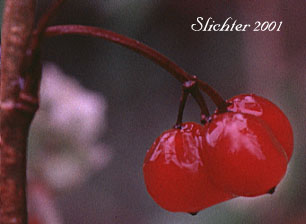 The
photo at right shows the fruits of high-bush cranberry. The photo was taken at
Multnomah Bog at the headwaters of Multnomah Creek, Columbia River Gorge........June
18, 2000.
The
photo at right shows the fruits of high-bush cranberry. The photo was taken at
Multnomah Bog at the headwaters of Multnomah Creek, Columbia River Gorge........June
18, 2000.
High-bush cranberry, also known as moosewood viburnum is a shrub with numerous straggling to suberect branches from 0.5-2 meters high. The herbage of the petioles, peduncles, and often of the leaf blades is covered with short raised glands. The leaves are palmately veined from the base and shallowly 3-lobed. The margins are sharply toothed. Individual leaves range from 3-10 cm long and are about equally wide. The upper leaf surface is a shiny dark green (As viewed above.) while the ventral surface of the leaf is covered with short stiff or coarse hairs. The leaves appear opposite along the stems.
The inflorescence is a cluster of several to fifty white flowers with the inflorescence measuring from 1-2.5 cm across. The inflorescence is borne on short axillary shoots which bear a single pair of leaves. Individual flowers are five-lobed and measure 4-7 mm across with the stamens not extending from the mouth of the flower. The fruits are ellipsoid in shape, red in color and measure from 1-1.5 cm long. They contain a large flattened stone and are tart with a "cranberry" taste.
High-bush cranberry is not a true cranberry, which is a member of the heath family. However, the bright red fruits are edible by both humans and birds. It is suitable as an ornamental shrub s it is aphid-resistant and grows well in slightly acidic soils. The bright blossoms in spring and bright fall foliage help make it a standout shrub!
High-bush cranberry is found in moist woods, swamps, and on streambanks.
High-bush cranberry may be found from Alaska south to the Cascades of northern Oregon and east to Newfoundland and hence south to northern Idaho, Colorado, Minnesota and Pennsylvania.